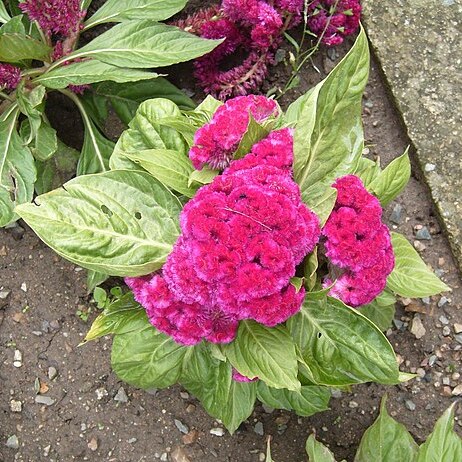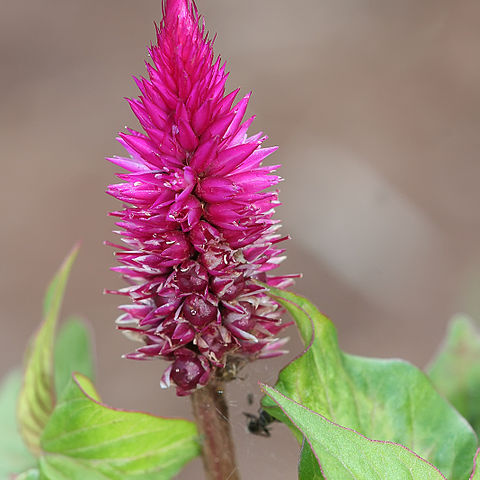Annual or perennial herbs or shrubs, sometimes climbing. Leaves alternate, entire or lobed, subsessile or petiolate; "stipular" leaves sometimes present in axils of normal leaves, lanceolate or falcate. Inflorescence of lax or dense terminal or axillary spikes, thyrses or panicles, in cultivars the spikes sometimes fasciated; bract 1 and bracteoles 2, persistent. Flowers bisexual, not aggregated into glomerules; tepals 5, free, scarious, striate; stamens 5, filaments expanded below and united for less than 1/2 their length in a staminal cup, rarely alternating with short teeth, anthers 4-locular, introrse, pseudostaminodia minute or absent; ovary (1-)2-to multi-ovulate, style short or long, stigmas 2-3. Fruit a circumscissile capsule (sometimes referred to as a utricle), sometimes thickened above; seeds 2 or more, sometimes strongly compressed, orbicular or subovoid, reticulate, shining, exarillate, embryo annular.
Erect, entirely glabrous annuals. Stem angular-ribbed. Leaves alternate, petioled, ovate to linear, entire or subentire, often with small semilunar leaves in the axils. Flowers ☿, in simple or branched, dense or interrupted, sometimes deformed, terminal or axillary spikes, solitary in axil of bract, subtended by 2 bracteoles. Tepals 5, free, during anthesis erecto-patent or spreading, before and after anthesis erect, ovate-oblong, acute, scarious, longitudinally nerved. Stamens 5; filaments at the base connate in a cup; free parts linear from a triangular base, often alternating with minute, triangular pseudo-staminodes; anthers oblong-linear, 2-celled (4-locellate). Ovary sessile with broad base; ovules ∞, on short funicles; style 1, filiform, persistent; stigma capitate, faintly 2-3-lobed. Utricle thin-walled, cir-cumsciss in or about the middle. Seeds 1-∞, lenticular, shining black.
Annual or perennial herbs, sometimes rather woody at the base, occasionally scandent. Leaves alternate, simple, entire or somewhat lobed. Flowers small, bibracteolate, hermaphrodite, in spikes or more generally dense to lax axillary and terminal bracteate thyrses (the uppermost frequently forming a panicle), lateral cymes lax to dense and forming sessile clusters, the inflorescence then spiciform. Perianth-segments 5, free, equal. Stamens 5, the filaments fused below into a short sheath, the free portions deltoid below and filiform above; anthers bilocular. Ovary with few-many (rarely solitary) ovules; style elongate to almost obsolete; stigmas usually 2–3. Capsule circumscissile, sometimes thickened above. Seeds black, usually strongly compressed and shining, roundish, feebly to strongly reticulate, grooved or tuberculate.
Herbs, annual or perennial, or shrubs with erect or scandent, terete or angular stems. Leaves alternate, petiolate, entire or lobed. Inflorescence a terminal or axillary spike, solitary or clustered in leaf axils, sessile or pedunculate. Bracts and bracteoles persistent, membranous. Flowers solitary, sessile or pedicellate, bisexual. Tepals 5, persistent, free, equal, 1–many nerved. Stamens 5; filaments fused at the base into a short cup around the ovary; staminodes 0; pseudostaminodes present as tiny teeth or absent; anthers bilocular. Ovary with 2–many (rarely only 1) ovules; style elongate to almost obsolete; stigmas 2 or 3, capitate to subulate. Fruit a membranous utricle, circumscissle or rarely indehiscent. Seeds 2–many (rarely only 1), lenticular, black, shiny.
Herbs or subshrubs, annual or perennial. Stems erect or clambering-straggling. Leaves alternate, petiolate; blade mostly lanceolate, ovate, or deltate. Inflorescences terminal and often axillary spikes or panicles, often fasciated in cultivated forms, many-flowered. Flowers bisexual; tepals 3-5, distinct, membranous or scarious, usually glabrous; filaments connate basally into cups; anthers 4-locular; pseudostaminodes absent; ovules 3-many; style persistent, 0.2-4 mm; stigmas 2-3, capitate or subulate. Utricles ovoid, membranaceous, dehiscence centrally circumscissile. Seeds (2-)3-many, black, flattened. x = 9.
Shrubs, subshrubs, or annual herbs. Leaves alternate, petiolate; leaf blade ovate to linear, margin entire or nearly so. Inflorescences spicate, terminal or axillary. Flowers perfect; in axils of bracts, subtended by 2 bracteoles. Tepals 5, persistent, erect, spreading, colored, scarious, glabrous. Stamens 5; filaments connate into a cup at base, apical part free, linear; pseudostaminodes absent. Ovary 1-loculed; ovules 2 to many; style 1, persistent; stigma capitate, or 2-or 3-lobed. Utricles thinly walled, ovoid or globose, dehiscent by lid. Seeds black, lenticular.
Fls perfect; sep 5, distinct, erect, scarious, striate; stamens 5, connate at base; ovary subglobose; ovules 2–several; style none to elongate; stigmas capitate or subulate; utricle usually circumscissile at the middle; seeds 2–several, lenticular; annual or perennial herbs, or shrubs in the tropics, with alternate, petiolate, entire or lobed lvs; fls in terminal or axillary spikes or axillary glomerules; commonly white, silvery, or colored. 60, widespread.
Flowers bibracteolate, in spikes or more generally dense to lax terminal and axillary bracteate thyrses (the uppermost frequently forming a panicle), lateral cymes lax to dense and forming lateral clusters and the inflorescence then spiciform.
Stamens 5, the filaments fused below into a short cup, the free portions deltoid below and narrow above or more or less swollen below; pseudostaminodes absent but minute blunt intermediate teeth occasionally found; anthers bilocular.
Ovary with few to numerous ovules (one or two species occasionally with solitary ovules in some ovaries); style distinct and elongate to almost obsolete; stigmas 2–3, circular to filiform.
Seeds black, usually strongly compressed and shining, subcircular, feebly to strongly reticulate, grooved, punctate or tuberculate; endosperm present.
Annual or perennial herbs, occasionally rather woody at the base, occasionally scandent.
Capsule circumcissile, sometimes thickened at the apex.
Leaves alternate, simple, entire or somewhat lobed.
Perianth segments 5, free, all more or less equal.


